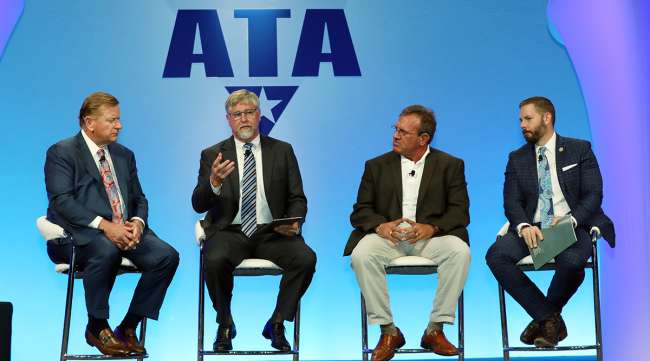Senior Reporter
Trucking Grapples With Impact of Legalized Marijuana

[Stay on top of transportation news: Get TTNews in your inbox.]
SAN DIEGO — The trucking industry needs to get out in front of the challenges it faces with the growing legalization of marijuana, according to the co-chairman of an American Trucking Associations subcommittee studying the impact of controlled substances.
“An employee in certain states can use marijuana on the weekend and come to work and take a random drug test and lose his employment and a way to make a living,” Harold Sumerford, CEO of J&M Tank Lines and co-chair of the Controlled Substances, Health and Wellness Subcommittee, told attendees at an Oct. 7 session during ATA’s Management Conference & Exhibition. “Whether that’s right or wrong in people’s minds, it’s got to be addressed because the problem is coming our way.”
Sumerford said that surveys reveal that 93 million people in U.S. support legalization of marijuana.
“According to the Pew Research Center, six of 10 Americans support legalization of marijuana,” Sumerford said. “When you add millennials, it increases to 74%.”
Greer Woodruff, senior vice president of safety for J.B. Hunt, said his company has been attempting to stay in front of the problem by hair testing all of its prospective employees for drug use.
Currently, the U.S. Department of Transportation only sanctions urine drug testing for such “safety-sensitive” prospective employees as truck drivers. Despite a congressional mandate for hair drug testing in 2015, the Department of Health and Human Services has yet to post a proposed rule.
Truck drivers are not legally allowed to use marijuana.
“Hair testing is a deterrent not only for marijuana but for other prohibited illegal drugs,” Woodruff said. “Hair testing became one of the tools in our toolbox since 2006, although we knew we were going to eliminate a certain population of drivers. But those were the drivers we didn’t want behind the wheel of our trucks.”
Woodruff said J.B. Hunt has seen a 63% reduction in the company’s random DOT urine test rate.
“We’ve seen a 93% reduction in post-accident positive urine results,” Woodruff said. “Our results demonstrate the deterrent effects of these drugs. We felt like it complements our safety culture and communicates that we are not going to permit illegal drug use behind the wheel of our trucks.
“The truth is, we’re probably pushing a lot of those drivers to other companies that don’t have the same type of drug-testing protocols that we have.”

An industrial hemp plant. (Minnesota Department of Agriculture)
Paul Enos, CEO of the Nevada Trucking Association and co-chairman of the working group, said that Nevada passed a voter initiative to legalize marijuana in 2016, but in 2019 the state Legislature passed some protections for marijuana users.
“2019 was an OK session for truckers. We actually did pretty well,” Enos said. “It was a great session for trial lawyers, deadbeats, stoners and felons.”
Enos said he believes the use of marijuana and legal hemp is going to continue to spread across the country.
“I think that we do need federal involvement,” Enos said. “And we are desperately in need of more research. Hey, we want to protect an employer’s right to be able to have a drug-proof workplace.”
Todd Simo, chief medical officer for HireRight, said impairment for marijuana and alcohol differ.
“People that go out and smoke pot and become intoxicated, they know they’re impaired so they compensate.
“I always say the alcoholic drives through the red light, while the intoxicated marijuana smoker stops at green lights, wondering if they should go,” Simo said. “They’re so aware that they’re messed up. The impairment of marijuana lasts.”
Want more news? Listen to today's daily briefing:




